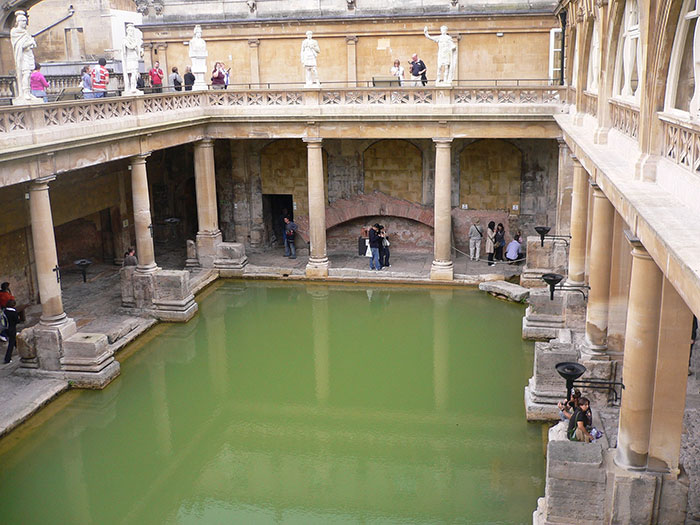A Brief History of Bathrooms
15th Nov 2018

The bathroom is one of the most used, and most important, rooms in the home. However, the comforts we associate with modern bathrooms, like plumbing, hot water and flushing toilets, are things that many of us take for granted. It was a long time before bathrooms became the multi-functional rooms that we know today. From Ancient Rome to the 21st century, let’s take a look at the fascinating history of the bathroom.
Ancient Bathing
The habit of bathing wasn’t always focused on hygiene. The first records for the use of baths go all the way back to 3000 B.C. During this time, water was seen as a purifying element and was often used during ritual ceremonies. In some cases, it was required for people to cleanse themselves before entering a sacred area.
Roman Baths
The Ancient Roman attitudes towards bathing are well-documented. The Romans built large thermal baths, both for public use and for the private homes of the wealthy. Public bathhouses were grand buildings and would usually feature a hot room, a warm room and a cold room. In some ways, they weren’t dissimilar to modern day spas.
For the Ancient Romans, bathing was about more than just hygiene; it was about relaxation and renewal. Bathing was also seen as a social activity; public bathhouses served as social gathering spots where friends would gather to discuss matters of the day and enjoy entertainment.
The famed Roman baths spread as far as the Empire itself, with ruins of Roman baths having been found in England, Northern Africa and the Middle East. Partially reconstructed ruins can still be seen today at the Roman Baths in Bath.
Middle Ages
Many of us might think that the Middle Ages saw a massive decline in bathing, but this isn’t necessarily the case. Public bathhouses were still commonly used during this period, though there was also an increase in indoor, private bathing, especially among the wealthy. It was commonplace among the affluent to bathe in a large wooden tub, usually placed in the bedroom.
16th – 18th Century
By the 16th century, the use of public baths had declined, and private bathing in the home became more popular. The reputation of bathhouses quickly degenerated, and they were officially closed down by Henry VIII in 1546.
Throughout the 16th, 17th and 18th centuries, bathing was increasingly neglected. Due to outbreaks of disease, people during this time were concerned that water could spread illness. It was said that warm water would weaken the body and widen pores, allowing disease to be absorbed into the body. Bathing became connected with the spread of dangerous diseases and, as a result, people during this period generally avoided it. Instead of bathing, people opted for wearing white linen undergarments; it was thought that wearing clean linen next to the skin would make the body clean.
Sir John Harrington published a book in 1596 describing how to construct a flushing toilet, and had one installed for Queen Elizabeth I in her royal palace. However, the invention proved unpopular with the royals; they preferred to use chamber pots, brought to them by their servants, in the comfort of their bedrooms. It wasn’t until the 19th century, after mass outbreak of cholera and the building of underground sewers, that the flushing toilet became commonplace in homes.
The Beginnings of the Bathroom
Prior to the 1850s, the three main parts of the bathroom (the toilet, the basin and the bath) were all in separate rooms. The middle-class and wealthy would have washstands in their bedrooms for washing up. For everyone else, washing up would be done in the family basin in the kitchen. Bathing would be done in a portable bath that would be heated in front of the fire. For most, this was done in the kitchen.
However, the late 19th century brought about numerous technological advancements that paved the way for the bathrooms we know today. After the invention of sewage systems, the modern flushing toilet eventually became commonplace in homes, with new houses being built with dedicated toilet rooms.
The discovery of germs resulted in a massive change in how people thought about hygiene; bathing was now seen as a necessity for good health. As modern plumbing systems were installed and gas heaters became widely available, personal bathing became much more common.
Showers were first introduced in the 19th century and were originally operated by a hand pump. However, by 1915, you could buy showers for the home that were not unlike the modern showers of today.
By the end of the 19th century, a dedicated room for bathing was much more commonplace. Free standing roll top baths, originally seen in finer homes in the 18th century, became more popular amongst the middle classes. Wooden elements began to give way to ornate patterned tiles.
20th Century
The 20th century saw bathrooms become more than just rooms of function. The bathroom, much like the kitchen, became a source of pride, particularly for women. The bathroom became a room for privacy, relaxation and escapism.
Modern Bathrooms
And now we come to the modern bathroom of today. Bathrooms today are all about creating that perfect balance between style and functionality. A place where you can get ready in the morning, then relax and unwind in the evening.
Bathroom styles today vary massively, ranging from traditional and elegant to sleek and modern. Technology plays a big part in today’s bathrooms; from underfloor heating to bluetooth mirrors, the options are endless. As you can see, we’ve come a long way from wooden baths and chamber pots.

 FREE delivery over £500*
FREE delivery over £500* Visit our showrooms
Visit our showrooms Finance options available*
Finance options available* Apply for a Trade Account
Apply for a Trade Account